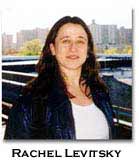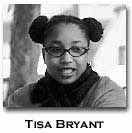Discussion
of Akilah Oliver's she said dialogues:
flesh memory
(Smokeproof/Erudite
Fangs 1999)
by
Rachel Levitsky and
Tisa Bryant


Rachel Levitsky: Who is she that is saying?
Tisa Bryant: She is the self, the lover, the inspiration, image, the authority, the mirror, the distance, memory, time itself. The multiplicity of the self, of experience, of desire, speaking. And perhaps even God, or god-as-conscience. I am thinking a lot about recovery of humanity, language, time, memory, the body, the fusion of decay and rebirth in A.O.'s work. I like how at once there is so much stillness and activity. Ruminations on where one should be placed, where one is and where one is told to be.
RL: I also sense that behind the serenity, or stillness is a desire to scream out a certain polemic or redirection of the world where she is placed and where she places herself. My sense is of a world which past identity is more than identity but never leaves identity behind. Most apparently there are the two most demanding and sensual identities of lesbian sex and her particular black experience–St Louis, her grandmother, food, Curtis Mayfield–there is also drug identity, political identity, and that of the romantic, well then why stop there, the person of faith. I see a cataloging of selves, romance, the city, the conceits of identity and history as they have thus been constructed, and through the catalog is a construction of a figure of some sort of majestic power, Whitmanesque, also HD's statue. She is both constructing herself and directing herself somewhere.
TB:
Or being directed. The spiritual aspect that we've both made reference
to is pivotal. There are 12 steps and 12 apostles. There is ascension.
There are many types of baptisms, of blood, rain, tears, cum. There is
much rising and falling. She's seen many rise from baptismal waters and
remain exactly the same. How does one save oneself and remain the same?
With salvation often comes renunciation. That is one big tug of war here,
between speaking on experience, and release from it, giving this truth
to the air as a freedom-via-renunciation, and a positive appraisal of
experience, the romanticism of survival.
RL: Hélène Cixous talks about the writer as a walker,
and this too in your reference, the writer exiles herself, wanders, in
order to get to the word. Oliver’s wandering is a directed one, not
by land but by psychic terrain, she will direct her pen into the places
that have been forced open by the severed penis, "sew patches on
the holes." Understanding their impermanence.
TB: As reflected too by nature, land or landlessness, the embodiment of two landscapes in the cover artwork by Barbiero Barro Gizzi.
RL: The stunned and jailed eye, the body longing and powerful, the mythical mystical city, the ancient tree, the constructed post modern form.
TB: These images also remind me of Renee Gladman’s response to David Huffman's "autobots" paintings, floating elements of land and belonging, of being and not being in and of place, a time.
RL: Huffman's autobots I see as degraded sci fi, or re-realized sci fi, a clarification, that the machines won't make us less human, won’t make us in fact autobots. Oliver has a line, "the machine is always on call when you can" (p55)–a smart irony, the machine not making the lover truly more available or more loving or more than what she is without it.
TB: Yet "she said" approaches the psychic and physical
body part by part building into, as we began with--a construction. Of
something needed but not yet seen, possessed. As the (as yet unconstructed)
museum of slave shackles and tongue-holds. We know all the material needed
is out there, is being held. There is a need of rescue. Flesh Memory
also brings to mind M. Nourbese Philip’s she tries her tongue,
her silence softly breaks. In it is a definition of the word ‘parsing’:
"the exercise of dis-membering language into fragmentary cells that
forget to re-member."
RL: Writing as rescue, "that words are not frivolous."
I want to
make a connection between the poet/speaker/shes (goddess and mortal) insistence
on the sanctity of the human despite the faith in the deity and the presence
in this work, of the city. As differing from a nature landscape–the
city in which the contradictions are unsmoothable or unexplainable in
any simple notions of divinity. And yet there is, structurally and textually,
a movement toward resolution through love–"take my hand, lead
me on," (p.71)–differs from earlier, more distant, (p.34) "love
is a condition of the imagination."
TB: I'm reading St. Louis as the (should be) sanctified city, one "natural" to her memory, a place to return to, cup healing albeit turbulent waters from, where the goddess lived as a child, where there was once a little girl, and LA as the ambivalent lover, the lover that makes the poet/speaker/shes ambivalent. (P. 50), "the party's been fun & I want to go home" is so much a spiritual, the "I want to go home" the open arms of a robed choir. Here again, goddess. On page 51, LA sounds devoid of spirit, but someplace it takes lots of will to leave, like a drug. Does she ever call it Los Angeles, the angels, or is it always L.A. something that stands for something else, a muted musical note on the scale.
RL:
LA the bad love, the one that must be left though the desperation is ambivalent.
The song quality at times chant like and at times both concrete and aphoristic.
There are these lines, "only a woman can empty so fully," (p.25)
"simple language of a tree," (p.16) "dust tracks over a
road that ain't georgia" (p.8) that are so singable I imagine a tune.
TB:
"Dust tracks..." recalls Zora Neale Hurston recalling the tune,
just as you hear it. There's so much blues. And gospel. I am reminded
of gospel songs like, "Nobody Can Do Me Like Jesus." The umbilicus
between the blues and gospel. there is a striving toward union, binding
one inside the other.
BIO: Tisa Bryant’s work has appeared in Clamour, Kenning, BLithe House Quarterly, and the anthology Children of the Dream: Our Own Stories of Growing Up Black in America (Pocket Books, 1999). Her work will appear in Chain, and in the anthologies Beyond the Frontier (Black Classics Press, 2000), Step Into A World: A Global Anthology Of The New Black Literature (John Wiley and Sons, Fall 2000), and What Is Not Said. Tzimmes is a forthcoming chapbook from a+ bend press.
BIO: Rachel Levitsky lives in Brooklyn and teaches poetry in grade schools. She has run several poetry reading series, and currently curates the Belladonna Series at the Bluestockings Women’s Bookstore in New York City. She is the author of four chapbooks, 2(1x1)Portraits (Baksun Books, 1998), The Adventures of Yaya and Grace (Potes & Poets, 1999), Cartographies of Error (Leroy, 1999) and Dearly, (a+bend, 1999).